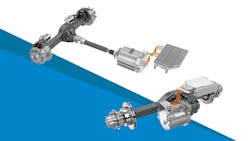With many states setting zero-emission goals for cars and heavy trucks, the time is right for fleets to thoroughly start exploring the benefits of electrification and e-propulsion options. Yet, the electric vehicle (EV) space can be confusing with myriad options available.
While an e-propulsion system can be assembled with components from various suppliers, a compelling case can be made for using a single-source supplier resulting in a highly integrated, reliable, purpose-built system.
On the contrary, a system that is independently pieced together can potentially result in physical and performance compromises. Additionally, the components will need to be integrated while still meeting safety compliance requirements at both the system and vehicle levels. Future issues also can surface if the system needs to be augmented with controls and software.
See also: Lessons learned about electrification
A single-source supplier can offer an e-propulsion system that is highly engineered, purpose-built, and reliable. When it comes to e-propulsion systems, fleets have a variety of options.
One of the big pluses of using electricity to power vehicles is that the electric truck has an energy efficiency ratio that is about 3.5 times greater than that of a diesel engine at highway speeds. When operating in stop-and-go applications, that efficiency is five to seven times greater.
Another benefit is the reduced maintenance needs of an e-propulsion system due to the estimated 30%-40% fewer moving parts than its diesel counterparts. In addition, fleets can anticipate extended maintenance schedules for EVs with only basic axle lube maintenance and high-voltage cooling system maintenance at approximately 100,000 miles. It is always a good idea to periodically perform a visual inspection for cable wear, hose fatigue, leaks, and other standard visual checks you would perform on any commercial vehicle.
Driver attraction and retention is another benefit of moving to electric propulsion. Drivers who have already experienced electrified vehicles say they are easy to operate and they like the fact that an EV’s rapid acceleration makes it safer to merge into moving traffic. They also report that EVs are quieter resulting in less fatigue and an overall more positive driving experience.
Fuel and maintenance savings along with positive driver reactions are great benefits, but a reduction in harmful emissions is important as well. Responsible companies are taking steps to ensure a cleaner environment for current and future generations. Of course, there will be a learning curve when it comes to the proper use of any new EV technology, so training will be essential and employ a multifaceted approach that includes online learning, phone-based assistance, and in-person training.
See also: Jumping on the EV bandwagon
Online material needs to be specific to e-propulsion and should include maintenance fundamentals, critical safety concerns, and detailed service manuals for technicians to use as reference. Training videos and in-person training are also great options to share the proper way to perform important service procedures. Phone personnel fielding calls from fleets should be knowledgeable about the nuances of the various types of e-propulsion systems or quickly connect the caller with an electrification specialist.
The industry is moving rapidly toward electrification, especially in certain market segments like urban delivery and regional haul. Developments are occurring every day that will make e-propulsion a viable option for additional markets in the not-too-distant future. Success in electrification ultimately will be based on partnering with the right supplier. Look for one that has the experience and is well-prepared to help you on your electrification journey.
Jeremy Frenznick is senior director of engineering for Dana’s Commercial Vehicle (CV) Drive and Motion Systems business responsible for applications and advanced engineering for the business. He helps to lead the innovation strategy for CV and provide a stronger customer-centric focus.
About the Author
Jeremy Frenznick
Jeremy Frenznick is senior director of engineering for Dana’s Commercial Vehicle (CV) Drive and Motion Systems business responsible for applications and advanced engineering for the business. Specifically, he helps to lead the innovation strategy for CV and provide a stronger customer-centric focus.
Prior to this role, Frenznick served as director of product engineering responsible for driveline component design across both the Light Vehicle and Commercial Vehicle businesses. He also worked closely with each segment in Dana to ensure that we were leveraging our core design principles across the entire organization.
He joined Dana in 2011 as a product engineer. Since that time, he has held various positions within product, advanced development, and applications engineering, including serving as senior manager of CV applications engineering.
Frenznick holds a bachelor’s degree in mechanical engineering from Kettering University and a Master of Engineering Management degree from Lawrence Technological University. He also was certified as a Shainin Red X Master in 2016.
